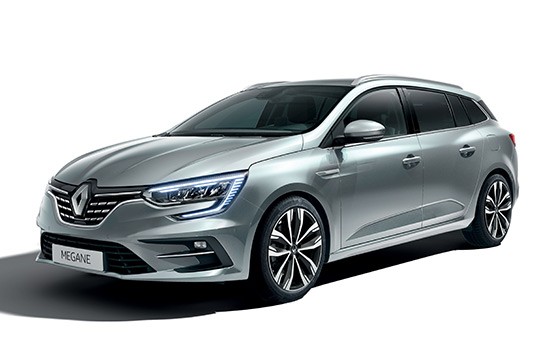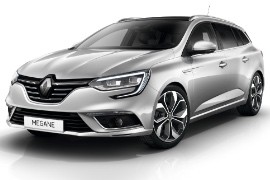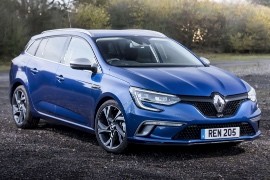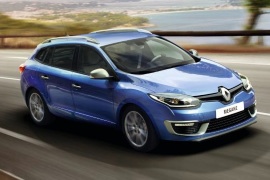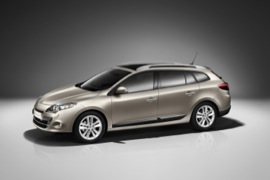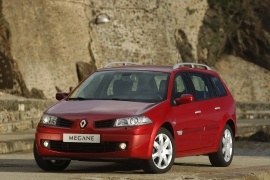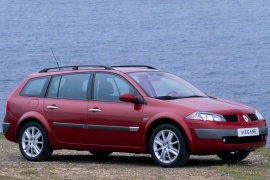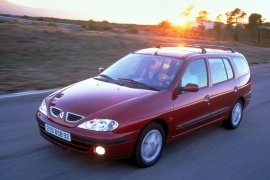RENAULT Megane Estate Models/Series Timeline, Specifications & Photos
First production year: 1999
Engines: Gasoline, Diesel, Hybrid
Body style: Wagon (station wagon, estate, combi, touring)
The french manufacturer broke the silence in the beginning of 2020 with the introduction of the new, face-lifted generation of its top-seller in the compact range, the Megane. The biggest improvements are on the tech-department, which are added to a slightly modified bodywork.
On the outside, the new Megane was improved with a new pair of headlights, which received LED technology for better visibility. The plug-in estate version has a 434 liter trunk-space (15.3 cu-ft), 84-liters (3 cu-ft) less than the non-hybrid versions.
Renault was at the forefront of electric mobility in Europe. The French carmaker hase a line-up of electric vehicles ranging from the two-seater Twizy up to the light commercial vehicles. Now it made a bold move into the plug-in hybrid (PHEV) technology, two years after buying Mitsubishi Motors, who already had this technology in production. The Renault Megane E-TECH plug-in hybrid can run 65 km (40 miles) purely electric in the mixed cycle or 50 km (31 miles) in urban environment (according to the WLTP cycle).
The face-lifted Megane will lose the GT-Line trim, which has been replaced with the new RS-Line badge. Compared with the GT-Line, the new trim will have a sportier look both on the inside and on the outside of the vehicle.
The 2016 Renault Megane Estate returned on the market with the true intention to get more out of the station wagon segment. It started with a good platform, a good engine choice, and a decent price.
Renault managed to offer estate versions for almost all of its lineup. The French can be trusted when they are building cars for families. The Megane Estate is a good example. A nice design, with lots of curved surfaces, a nice interior and enough technology to satisfy the driver.
The R-Link 2 unit featured a portrait-type touchscreens TFT display in the central console. It had various features and a rotating-knob controller placed between the front seats. Other features available for the car were the automatic climate control system with a pollution analyzer. It could get a touch of luxury with leather seats. It also has great scores in safety tests.
The engine choice is extensive, ranging from 90 hp up to 205 hp, with good offers regarding both gasoline or diesel units. A choice of manual and dual-clutch transmission was available too. Moreover, it had an optional four-wheel-steering, which was unusual for the compact-car segment.
Inside, the room was large enough for five people and a big, 580 liters (20.5 cu-ft) trunk space, with the rear seats up. With the seats down, the total loading length was 2.7 meters (8.8 ft).
Renault introduced the fourth generation of the Megane Estate in 2016 and, apart from the rest of the range, it prepared a special trim level: the GT.
There was more than just a special color, rims, and aero package on the Megane Estate. The Megane Estate GT was the sporty station-wagon that could carry all the needs for a family but still be driven hard and offer plenty of pleasure for the one behind the wheel.
A surrounding daytime running light encircled the headlights, and that gave the car a distinctive personality. But that was not enough for the French carmaker that employed the Renault Sport division to somehow transform the station-wagon. The Dieppe crew worked on the front bumper and installed a new one with a different design for the lower side, where they added a lip to reduce the ground effect. Two grilles were placed on the exterior to mimic air-scoops for the brakes, where they put the fog lights. A mandatory roof-spoiler extended the roofline and made the airflow cleaner behind the car. There was nothing installed just for the look.
The interior revealed a different character of the car, with sculptured bucket seats for the front occupants. A big R-Link infotainment system was installed on the center stack. Next to the gear-selector, a special button with a flag showed started to raise questions about the car's character.
The drivetrain was different than the rest of the Megane Estate range. A 4-wheel steering system was installed, which helped the car get faster around the corners. The GT featured a standard, 6- or 7-speed automatic (dual-clutch) transmission with paddle shifters (depending n the engine). The launch-control mode was standard as well.
At the 2013 Frankfurt Motor Show, Renault unveiled the facelifted version of the third generation of the Megane lineup, including the station-wagon version dubbed Sport Tourer.
Renault offered the Megane in various shapes, such as a sedan, a three- and five-door hatchback, a convertible, and a station wagon with a sportier look. The updated version of the Megane came with a few improvements, mainly in the engineering department.
Renault didn't want to change bodywork panels since that could lead to major costs. That forced its design team to create new headlights, for instance, but keeping their original shape. While its predecessor featured LED daytime running lights placed below the headlamps, the facelifted version had them moved lower, in the side bumper's side scoops. Another essential update was for the grille, which received a larger chromed logo placed on the grille instead of on the hood as on the non-facelifted version. In addition, the hood was new. From its profile, the Sport Tourer lived up to its name and showcased a slightly sloped-down roofline towards the back of the vehicle. In the rear, the tailgate was raked-forward and then arched down.
Inside, the main difference was the new R-Link infotainment system placed above the center stack. That brought the French automaker closer to its main competitors, even though Renault knew that it wasn't such high demand among its customers. But, just like its predecessor, the 2014 Megane Sport Tourer featured a split-folding rear bench that could expand the trunk area from its regular 524 liters (18.5 cu-ft) up to 1,595 liters (56.33 cu-ft).
Under the hood, the engine lineup was upgraded to Euro 6 emission standards. In addition, Renault introduced a new 1.33-liter turbocharged gasoline unit and a dual-clutch automatic gearbox.
Renault unveiled the third generation of its compact-segment range in late 2008 and, in 2009, it introduced the station-wagon version.
The compact segment was rising again after the world financial crisis, and Renault rushed to offer a complete lineup for the successful Megane nameplate. While some customers were eager to get their hands on the beautiful three-door version, the station-wagon was the choice of families and salesmen across the European continent. It was a decent vehicle, good and practical.
Renault dropped the original idea of a classic station wagon with a wide window behind the rear doors. The overall look was closer to a hatchback with a longer roof. At the front, it used the same front fascia with swept-back headlights on the fenders, and the grille was installed only in the front apron, not above the bumper. From its sides, the turn-signals on the mirrors and the body-colored door handles were fitted as standard.
Inside, Renault installed a curved dashboard covered in a soft material. Its instrument cluster sported a digital speedometer in the middle flanked by an analog tachometer on the left and a smalls LCD for the on-board computer on the right. In the middle of the dash panel, an additional cluster featured an additional display for the audio system, showing the caller-ID information or other relevant data from the radio or the CD-player. The Megane's interior was fit for up to five adults, with two, almost flat, seats at the front and a split-folding bench in the back. The user could have expanded the trunk area from its regular 524 liters (18.5 cu-ft) up to 1,595 liters (56.33 cu-ft).
Renault offered the Megane with up to 14 engine choices, with automatic or CVT transmissions, depending on the market.
RENAULT Megane Estate 1.2L TCe 6MT FWD (130 HP)
RENAULT Megane Estate 1.2L TCe Eco2 6MT FWD (115 HP)
RENAULT Megane Estate 1.6L 16v 5MT FWD (100 HP)
RENAULT Megane Estate 1.6L 16v 6MT FWD (110 HP)
RENAULT Megane Estate 2.0L TCe 6MT FWD (190 HP)
RENAULT Megane Estate 1.5L dCi Eco2 5MT FWD (90 HP)
RENAULT Megane Estate 1.5L dCi Eco2 6AT FWD (110 HP)
RENAULT Megane Estate 1.5L dCi Eco2 6MT FWD (110 HP)
RENAULT Megane Estate 1.5L dCi Eco2 6MT FWD (95 HP)
RENAULT Megane Estate 1.5L dCi Eco2 Energy 6MT FWD (110 HP)
The French carmaker introduced a refreshed version of the Megane's second generation in 2006 for the entire range, including the station wagon.
After a successful first-generation, Renault was ready to get more customers with the Megane sequel on the European market. That's why it tried improving the car in all the areas, and especially on the safety side, where the car got a five-star rating in the EuroNCAP crash tests.
The facelifted version of the Megane Station Wagon got a new front fascia, with body-colored plastic moldings over the bumpers and sides, which were black on the 2003 version. The carmaker installed the same angular headlights that were continued on the same line with the black grille. On the lower side of the front bumper, the carmaker installed round fog lights as standard for the entire range.
The interior showed a new navigation system designed together with TomTom. Its retractable screen on top of the dashboard was unique on the market, at least on the budget car segment. Like its predecessor, it featured a 60/40 split bench in the rear, which increased the trunk size from 520 (18.4 cu-ft) liters to 1,600 liters (56.5 cu-ft).
Under the hood, Renault installed a choice of seven engines, both gasoline, and turbo-diesel. It was available exclusively with a manual gearbox.
One year after the introduction of the Megane's second generation, Renault also brought the long-roof version for it, which was known as the Megane Estate.
With an increased demand for station wagons in the compact segment, Renault felt obliged to provide one since the Megane lineup was such a successful vehicle. But it didn't rush and took one step at a time and brought the hatchback first. The Estate came in 2003.
With its angular lines, the second generation of the Megane marked a clear departure from its predecessor. The front fascia resembled a pair of wings, with the grille and the headlights following the same lines. In the middle, the bird-beak styling element supported the chromed badge. The lower bumper received an additional grille flanked by the optional foglamps to soften the angular shapes. For the station wagon version, Renault created a sportier look than just a regular family hauler. Its roof line was slightly sloped-down. Furthermore, the third row of windows was narrowed at the back before the D-pillars.
Inside, the carmaker introduced better materials than its predecessor, while the instrument cluster received a clean design with two large dials for the speedometer and tachometer. Moreover, an LCD took center stage between them. On the center stack, the carmaker added a silver plastic trim that surrounded the stereo and the climate control unit, while the slot for the keycard was placed lower, just above the center console. Thanks to the almost flat floor, the car provided enough room for five passengers. The split-folding bench allowed the customers to increase the trunk space from 521 liters (18.4 cu-ft) to 1600 liters (56.5 cu-ft).
Under the hood, Renault installed a wide choice of engines ranging between 1.4- and 2.0-liter, either with gasoline or direct-fuel injected turbo-diesels. For specific versions, the French carmaker installed a four-speed automatic transmission.
The French carmaker upgraded the Megane's first generation in 1999, and that refresh also included the station wagon version, traditionally named Estate.
Renault didn't introduce the long-roof version of the Megane in the beginning. The automaker considered that since it already offered the minivan Megane Scenic, that wouldn't be necessary. But the French team was wrong, and, in 1998, it added the Estate in the lineup. A year later, this version also received a refresh for all markets.
Sharing the front fascia with the rest of the Megane range was the right thing to do on this version. Its redesigned headlights with a tear-drop shape received clear lenses on the headlights. From its profile, the long-roof version kept a similar design to its sedan sibling. After the B-pillar, the car was different, with an extended roof over the luggage compartment and side windows behind the rear doors.
Inside, the Megane still offered hard plastic interior parts, but with new vents on the center stack and a three-spoke steering wheel. In addition, the automaker installed a side-passenger airbag. At the back, the car featured the same split-folding bench as the hatchback (five-door) version of the Megane.
Under the hood, Renault installed a wide choice of turbo-diesel and gasoline engines. All of them were paired with an automatic transmission.
